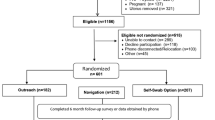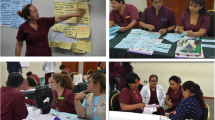Abstract
Peru struggles to prevent cervical cancer (CC). In the jungle, prevention programs suffer from significant barriers although technology exists to detect CC precursors. This study used community based participatory research (CBPR) methods to overcome barriers. The objective was to evaluate the utility of CBPR techniques in a mother–child screen/treat and vaccinate program for CC prevention in the Peruvian jungle. The CC prevention program used self-sampling for human papillomavirus (HPV) for screening, cryotherapy for treatment and the HPV vaccine Gardasil for vaccination. Community health leaders (HL) from around Iquitos participated in a two half day educational course. The HLs then decided how to implement interventions in their villages or urban sectors. The success of the program was measured by: (1) ability of the HLs to determine an implementation plan, (2) proper use of research forms, (3) participation and retention rates, and (4) participants’ satisfaction. HLs successfully registered 320 women at soup kitchens, schools, and health posts. Screening, treatment, and vaccination were successfully carried out using forms for registration, consent, and results with minimum error. In the screen/treat intervention 100 % of participants gave an HPV sample and 99.7 % reported high satisfaction; 81 % of HPV + women were treated, and 57 % returned for 6-month followup. Vaccine intervention: 98 % of girls received the 1st vaccine, 88 % of those received the 2nd, and 65 % the 3rd. CBPR techniques successfully helped implement a screen/treat and vaccinate CC prevention program around Iquitos, Peru. These techniques may be appropriate for large-scale preventive health-care interventions.


Similar content being viewed by others
Notes
Jerome L. Belinson has received support in kind (reagents and testing) and funds for direct support and research, under the auspices of Preventive Oncology International Inc., from Hologic Inc., Qiagen, Gen-Probe, Merck Inc., BGI Shenzhen, and GE Healthcare. The other authors have no conflicts of interest to report. This work was supported by the National Institutes of Health Office of the Director, Fogarty International Center, Office of AIDS Research, National Cancer Center, National Eye Institute, National Heart, Blood, and Lung Institute, National Institute of Dental and Craniofacial Research, National Institute On Drug Abuse, National Institute of Mental Health, National Institute of Allergy and Infectious Diseases, and National Institutes of Health Office of Women’s Health and Research through the Fogarty International Clinical Research Scholars and Fellows Program at Vanderbilt University (R24 TW007988) and the American Relief and Recovery Act, Merck Inc. “Investigator Initiated Studies Program”, and Preventive Oncology International.
References
Ferlay, J., Shin, HR., Bray, F., Forman, D., Mathers, C., Parkin, DM. (2010). GLOBOCAN v1.2, Cancer incidence and mortality worldwide: IARC cancerbase No. 10 [Internet]. Lyon, France: International agency for research on cancer. Available from: http://globocan.iarc.fr. Accessed on 30 Oct 2011.
WHO/ICO information centre on HPV and cervical cancer (HPV Information Centre). Human papillomavirus and related cancers in Peru. Summary report 2010. Available at www.who.int/hpvcentre.
Paz Soldan, V., Lee, F., Carcamo, C., Garnett, G. P., & Garcia, P. (2008). Who is getting Pap smears in urban Peru? International Journal of Epidemiology, 37, 862–869.
Almonte, M., Ferreccio, C., Winkler, J. L., Cuzick, J., Tsu, V., Robles, S., et al. (2007). Cervical screening by visual inspection, HPV testing, liquid-based and conventional cytology in Amazonian Peru. International Journal of Cancer, 121(4), 796–802.
Garcia, F., Barker, B., Santos, C., Brown, E. M., Nuño, T., Giuliano, A., et al. (2003). Cross-sectional study of patient- and physician-collected cervical cytology and human papillomavirus. Obstetrics and Gynecology, 102(2), 266–272.
Belinson, Jh, Duh, H., Yang, B., Wu, R., Belinson, S. E., Qu, X., et al. (2011). Improved sensitivity of vaginal self-collection and high-risk human papillomavirus testing. International Journal of Cancer, 130(8), 1855–1860.
Anhang, R., Nelson, J. A., Telerant, R., Chiasson, M. A., & Wright, T. C. (2005). Acceptability of self-collection of specimens for HPV DNA testing in an urban population. Journal of Women’s Health, 14, 721–728.
Dzuba, I. G., Díaz, E. Y., Allen, B., Leonard, Y. F., Lazcano Ponce, E. C., Shah, K. V., et al. (2002). The acceptability of self-collected samples for HPV testing versus the Pap test as alternatives in cervical cancer screening. Journal of Women’s Health and Gender-Based Medicine, 11(3), 265–275.
Mitchell, S., Ogilvie, G., Steinberg, M., Sekikubo, M., Biryabarema, C., & Money, D. (2011). Assessing women’s willingness to collect their own cervical samples for HPV testing as part of the ASPIRE cervical cancer screening project in Uganda. International Journal of Gynaecology and Obstetrics, 2, 111–115.
Taylor, S., Wang, C., Wright, T. C., Denny, L., & Kuhn, L. (2011). A comparison of human papillomavirus testing of clinician-collected and self-collected samples during follow-up after screen-and-treat. International Journal of Cancer, 129(4), 879–886.
Tisci, S. M., Shen, Y. H. M., Fife, D. R., Huang, J., Goycoolea, J., Ma, C. P., et al. (2003). Patient acceptance of self-sampling for human papillomavirus in rural China. Journal of Lower Genital Tract Disease, 7, 107–116.
Goldie, S. J., Gaffikin, L., Goldhaber-Fiebert, J. D., Gordillo-Tobar, A., Levin, C., Mahé, C., et al. (2005). Cost-effectiveness of cervical-cancer screening in five developing countries. New England Journal of Medicine, 353(20), 2158–2168.
McClung, E. C., & Blumenthal, P. D. (2012). Efficacy, safety, acceptability and affordability of cryotherapy: A review of current literature. Minerva Ginecologica, 64(2), 149–172.
Levinson, K. L., Abuelo, C., Chyung, E., Salmeron, J., Belinson, S. E., Sologuren, C. V., et al. (2013). The Peru cervical cancer prevention study (PERCAPS): Community-based participatory research in manchay. International Journal of Gynecological Cancer, 1, 141–147.
Du, H., Yi, J., Wu, R., Belinson, S., Qu, X., Yang, B., et al. (2011). A new PCR based mass spectrometry system for high-risk HPV Part II—clinical trial. American Journal of Clinical Pathology, 136(6), 920–923.
Levinson Kimberly, L., Abuelo, Carolina., Chyung, Eunice., Salmeron, Jorge., Belinson, Suzanne. E., Vallejos Sologuren, Carlos., Santos Ortiz, Carlos., Jose Vallejos, Maria., Belinson, Jerome, L. (2013). The Peru cervical cancer prevention study (PERCAPS): The technology to make screening accessible. Gynecologic Oncology. Accepted Jan 2013.
Brown, A., Jejeebhoy, J., Shah, I., Yount, K. Sexual relations among young people in developing countries: evidence from WHO case studies. Department of reproductive health and research family and community health World Health Organization Geneva. http://whqlibdoc.who.int/hq/2001/WHO_RHR_01.8.pdf.
Author information
Authors and Affiliations
Corresponding author
Rights and permissions
About this article
Cite this article
Abuelo, C.E., Levinson, K.L., Salmeron, J. et al. The Peru Cervical Cancer Screening Study (PERCAPS): The Design and Implementation of a Mother/Daughter Screen, Treat, and Vaccinate Program in the Peruvian Jungle. J Community Health 39, 409–415 (2014). https://doi.org/10.1007/s10900-013-9786-6
Published:
Issue Date:
DOI: https://doi.org/10.1007/s10900-013-9786-6




